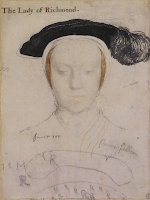“What is this post about?” you may wonder. “I
know that Henry VIII had six wives and I know their names”. Indeed. Henry VIII
had six wives and they are all very well-known historical figures:
Katherine of Aragon, Anne Boleyn, Jane Seymour, Anne of Cleves, Catherine Howard and Katherine Parr.
But when you actually read the original contemporary letters, the names of Henry VIII’s wives are different! So what were their real names?
Katherine of Aragon, Anne Boleyn, Jane Seymour, Anne of Cleves, Catherine Howard and Katherine Parr.
But when you actually read the original contemporary letters, the names of Henry VIII’s wives are different! So what were their real names?
Katherine of Aragon
Married Henry on 11
June 1509. He was 17, she was 23. Marriage annulled on 23 May 1533.
Married for 23 years and 11 months.
Born in Spain, Katherine’s Spanish name was
“Katalina”, but when she became Queen she used the anglicized version of her
original name. She signed her letters with “Katharine”, “Katherine”, “Katherina”,
and “Katharina”. In one of her prayer books, Katherine left the inscription: “This
boke ys myn Katherina the qwene”.
 |
| “This boke ys myn Katherina the qwene” |
 |
| "Katharina" |
Anne Boleyn
Married Henry on 14
November 1532 and 25 January 1533. He was 41, she was either 26 or 32.
Beheaded on 19 May 1536.
In a letter written in French to her father
from the Low Countries when she was a teenager, Anne used the French version of
her surname: “Anna de Boullan”. A letter she wrote to Cardinal Wolsey sometime
prior to the Cardinal’s disgrace in 1529 bears the signature “Anne Boleyn”. Between
December 1529 and August 1532 Anne started signing her letters as “Anne
Rochford”. In 1533 she became Queen and adapted a new signature: “Anne the
Queen” or, in original, “Anne the Qwene”.
 |
| "Anna de Boulan" |
Jane Seymour
Married Henry on 30 May 1536. He was 44, she
was 26. Died on 24 October 1537. Married for 1 year and 4 months.
Jane Seymour seems to be the only wife of Henry
VIII who spelled her name the same way we do it today, “Jane the Queen”.
Anne of Cleves
Married Henry on 6 January 1540. He was 48, she
was 24. Marriage annulled on 9 July 1540. Married for 6 months.
Anne was born in Germany and her name was
spelled “Anna”. She signed herself as “Anna, the daughter of Cleves” in a
letter she sent to Henry soon after the annulment of their marriage.
Catherine Howard
Married to Henry on 8 August 1540. He was 49,
she was between 17 and 22. Beheaded on 15 February 1542. Married for 2 years
and 6 months.
The only extant letter by Catherine Howard was addressed
to “Master [Thomas] Culpeper”, a gentleman of Henry VIII’s court who was later
beheaded as the Queen’s lover. Catherine signed this letter: “Yours as long as
life endures, Katheryn”.
 |
| "Yours as long as lyffe endures, Katheryn" |
Katherine Parr
Married Henry on 12 July 1543. He was 52, she
was 31. Survived the King. Married for 3 years and 6 months.There are several samples of Katherine Parr’s
handwriting from the period when she was Queen. She always signed her letters
“Kateryn the Quene KP” adding her initials in the end.
So, in the end, we have Katharina, Anne, Jane,
Anna, Katheryn and Kateryn. What a diversity!
Picture Sources:
http://exetercollegespecialcollections.com/tag/katherine-of-aragon/
http://smalldogsyndrome.com/tag/travel/page/3/






















